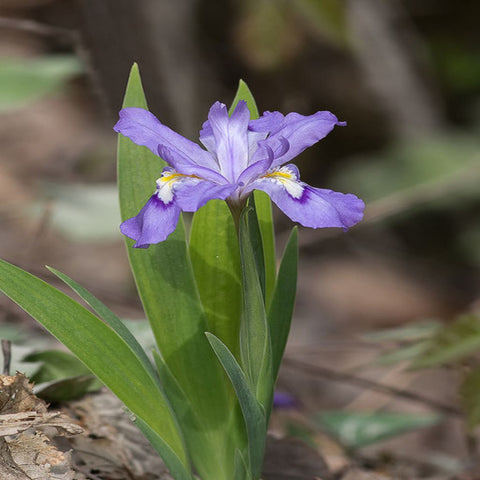

Dwarf Crested Iris - Iris cristata
Dwarf crested iris is a member of the Iris family. The flower is usually about one foot tall and features red and yellow stripes. The leaves are generally purple but may also be green. Dwarf crested iris can be found on the roadsides of Southern Texas and North Louisiana, but it is not native to either region. Dwarf crested iris is one of the most commonly encountered invasive species in the United States.
5 Reasons why dwarf crested iris is a good plant buy
Beautiful flowers
The flowers of dwarf crested iris are beautiful and bloom from early to late in the season, and the flowers also have a long vase life.
The plant is a show-stopper.
Dwarf crested iris makes an impressive addition to any garden. One plant can make an impact.
Variegated leaves
The leaves of dwarf crested iris are variegated, which means they have multiple colors. The color of the leaves can vary depending on the sun exposure, weather, and season.
The plant is hardy, long-blooming, and easy to grow.
Dwarf crested iris is hardy and drought tolerant. The dwarf iris also has a long blooming season, which makes it a great addition to any flower bed.
The plant can be grown from seed.
Dwarf crested iris is an excellent addition to any garden because it can be grown from seed, making the plant more economical than purchasing a plant for your yard. Dwarf crested iris has been known to self-seed in some areas, so be on the lookout for new plants if you buy a plant instead of planting it from seed.
HOW TO PLANT DWARF CRESTED IRIS
Dwarf crested iris is not challenging to grow as long as it is planted in the correct location. Dwarf crested iris prefers full to partial shade and well-drained soil. Make sure the area you plan on planting dwarf crested iris has been weeded and that you have dug out any roots left behind by other plants.
When to plant dwarf crested iris?
You can plant dwarf crested iris any time of the year, but the best times to plant are in the spring or fall when the temperatures are moderate. During the summer months, the dwarf crested iris should be watered regularly.
How to take care of dwarf crested iris
The plant requires regular watering. Water the plants until they are thoroughly soaked but not standing in water. If you notice the leaves turning yellow and standing water in the soil, your plant may be overwatered. If this happens, let the soil fully dry before watering again. When the ground becomes completely dry, it will help to kill roots that might have sprouted in the dry soil.
The Dwarf crested iris should be fertilized once every two weeks during the growing season and with a soluble fertilizer once every three months in the late fall and winter. Applying the fertilizer in the early morning or late afternoon is best because using it during the day's heat can burn the leaves.
Buy Dwarf Crested Iris online at Nance Plants.
It is best to prune dwarf crested iris during a dry period between mid-May and mid-June. The iris should be pruned back when they are dormant.
The dwarf crested iris is a beautiful, hardy, and long-blooming plant. The dwarf crested iris are great plants to add to your garden because they are easy to grow and maintain. Dwarf crested iris are also beautiful, which makes them a great addition to any garden.
FAQ
1. Do dwarf crested iris like sun or shade?
A. Dwarf crested iris (Iris cristata), prefers partial to full shade
2. Do Dwarf crested iris spread?
A. Yes, dwarf crested iris (Iris cristata) is known to spread and can form attractive ground covers in suitable conditions. This iris species has a rhizomatous growth habit, meaning it produces underground stems called rhizomes that spread horizontally.
One Year Guarantee on all Perennials & Ferns. See Healthy Plant Guarantee for more details.
Color:
Purple
Ships As:
Root/Rhizome
Season:
Spring-Summer
Zone:
3-9
Exposure:
Sun & Shade
Deer Resistant:
Yes
Native:
Yes




